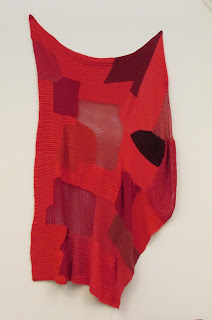Mary Lee Bendolph - Burgle Boys, 2007
"This exhibition presents the work of Black artists born between 1887 and 1965 who spent their lives and forged their careers in the American South. While large numbers of Black people had travelled to the northern states between 1910 and 1970 to escape racism, poverty and segregation - a movement known as the Great Migration - these artists remained. With their works, these artists confronted the harrowing history of enslaved African Americans, whose forced labour shaped the economic, social and agrarian culture of the deep South, as well as depicting everyday realities of economic inequality and oppression, social marginalisation and racial conflict. They drew their inspiration from daily life, the local environment, historical and current events, religion, music and the the African traditions they had inherited and studied. Not only are these concerns reflected in the subjects of their works, but they are also implicit in the materials used. The artists often incorporated scrap materials and objects such as tree branches and roots, as well as clay and sand into their works to create some of the most imaginative and powerful paintings, sculptures, quilts and assemblages of the twentieth century. Without access to formal art education or traditional galleries, many artists were taught by family members or friends, and often displayed their work on their front porches, on abandoned storefronts or in their own yards. Their careers were rooted in local communities from South Carolina to the Mississippi River Delta, and from isolated rural areas such as Gee's Bend, Alabama, to urban centres including Atlanta, Memphis and Miami." - Exhibition catalogue.
This exhibition appeared to be vastly different to the usual fare presented at the Royal Academy. It brought to mind my trip of a few years ago to Lille's Métropole Musée d'Art Moderne, d'Art Contemporain et d'Art Brut (LaM), and the amazing collection of outsider art displayed there (here). There, as here, people with a creative impulse but no formal training in art followed their urges and personal muses to create art from unconventional materials. As a result the aesthetic is quite rough being created from everyday scrap materials, but utilised with skill and dexterity to create some quite sophisticated outcomes. Although the majority of artists featured are unschooled in art historical movements or traditions, visitors with any knowledge of art history can easily make connections and see parallels in the work of other artists and craftsmen. I saw ancestral echoes across the Atlantic to the craftsmen of Benin and their beautiful Benin bronze plaques in the work of Ronald Lockett's piece - Sarah Lockett's Roses. There were also startling similarities in the work of Thornton Dial and Robert Rauschenberg's combines, and most obviously to me a drawing by Henry Speller which could easily have been mistaken for a work by artist Jean Dubuffet. Apart from the wonderful patterned quilts of the women of Gee's Bend, (one in particular employing a geometric pattern of concentric stitched angles which was actually made at a time in the 1930s when the European avant-garde were experimenting with geometric abstraction), my favourite piece in the exhibition was Charlie Lucas's - Three-Way Bicycle, which was like a three-dimensional version of a Cubistic Picasso painting, and expressed the joys and freedom of cycling perfectly. On leaving the RA building I passed a lovely textile work by contemporary black artist Emily Moore (last picture below), which echoed the stitched and pieced works of the Gee's Bend quilters.
Thornton Dial - Mrs Bendolph, 2002
Thornton Dial - The Stars of Everything, 2004
Thornton Dial - King of the Jungle, 1990
Ronald Lockett - Sarah Lockett's Roses, 1997
Ronald Lockett - Oklahoma, 1995
Mary Lee Bendolph - Burgle Boys, 2007
Thornton Dial - The Coming Dawn, 2011
Thornton Dial - Tree of Life (In the Image of Old Things), 1994
Thornton Dial - Blue Skies: The Birds that Didn't Learn How to Fly, 2008
Richard Dial - Which Prayer Ended Slavery?, 1998
Mary T. Smith - Untitled, 1984
Lonnie Holley - Keeping a Record of It (Harmful Music), 1986
Lonnie Holley - Spirit of the Man by the Chicken House Door, 1984
Lonnie Holley - Carrying the Lighter Child, 1986
Lonnie Holley - The Growth of Communication, 2022
Nellie Mae Rowe - Woman Wearing a Fish Hat, 1980
Jessie Aaron - Untitled, c. 1972
Bessie Harvey - Untitled, 1987
Archie Byron - Anatomy I, 1987
Jimmy Lee Sudduth - Atlanta, 1988
Jimmy Lee Sudduth - Caines Ridge Church, 1986 and Africa, mid-1980s
Mose Tolliver - Mary, 1986 and Self-Portrait, 1987
Henry Speller - People Looking at a Man on a Motorcycle, 1987
Sam Doyle - LeBe, late 1970s
Joe Minter - And He Hung His Head and Died, 1999
Charlie Lucas - Three-Way Bicycle, c.1985
Purvis Young - Carrying the Angel to the People, 1994
Purvis Young - Untitled (Baby), 1980s
Purvis Young - Untitled (Narrative Scene), 1980s
Rachel Carey George - 'Housetop' - sixteen-block 'Half-Log Cabin' variation, 1930s
Martha Jane Pettway - 'Housetop' - nine-block 'Half-Log Cabin' variation, c.1945
Loretta Pettway - 'String-pieced Quilt, 1960
Flora Moore - 'Log Cabin' variation, c. 1975
Loretta Pettway Bennett - Medallion, 2005
Essie Bendolph Pettway - Side Seams, 2018
Marlene Bennett Jones - Triangles, 2021
Emily Moore - Maroon, 2022
Souls Grown Deep like the Rivers: Black Artists from the American South
until 18th June
The Gabrielle Jungels-Winkler Galleries
Royal Academy of Art
Burlington House
Piccadilly
London
W1












































No comments:
Post a Comment